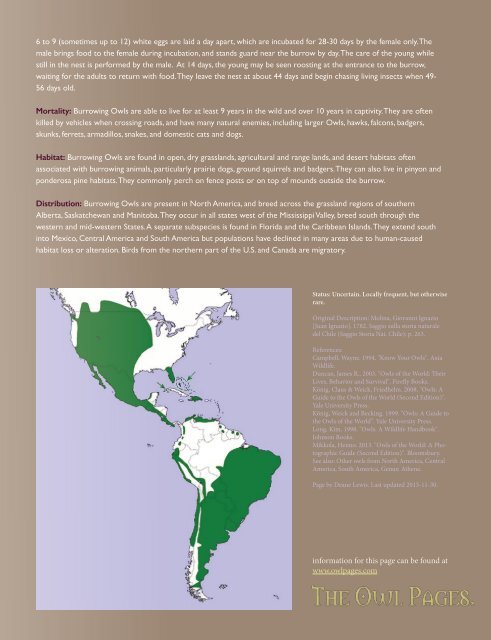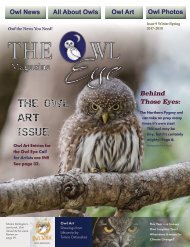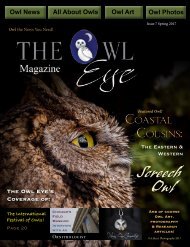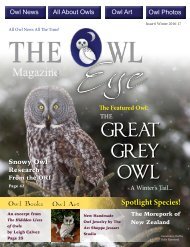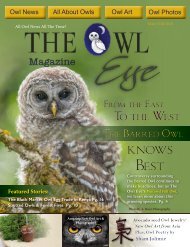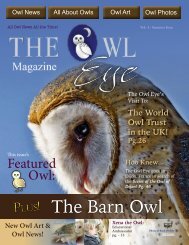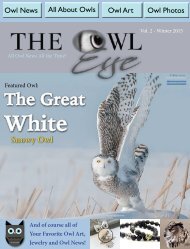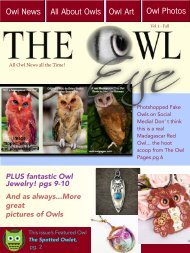The Owl Eye Magazine Issue 8
You also want an ePaper? Increase the reach of your titles
YUMPU automatically turns print PDFs into web optimized ePapers that Google loves.
6 to 9 (sometimes up to 12) white eggs are laid a day apart, which are incubated for 28-30 days by the female only. <strong>The</strong><br />
male brings food to the female during incubation, and stands guard near the burrow by day. <strong>The</strong> care of the young while<br />
still in the nest is performed by the male. At 14 days, the young may be seen roosting at the entrance to the burrow,<br />
waiting for the adults to return with food. <strong>The</strong>y leave the nest at about 44 days and begin chasing living insects when 49-<br />
56 days old.<br />
Mortality: Burrowing <strong>Owl</strong>s are able to live for at least 9 years in the wild and over 10 years in captivity. <strong>The</strong>y are often<br />
killed by vehicles when crossing roads, and have many natural enemies, including larger <strong>Owl</strong>s, hawks, falcons, badgers,<br />
skunks, ferrets, armadillos, snakes, and domestic cats and dogs.<br />
Habitat: Burrowing <strong>Owl</strong>s are found in open, dry grasslands, agricultural and range lands, and desert habitats often<br />
associated with burrowing animals, particularly prairie dogs, ground squirrels and badgers. <strong>The</strong>y can also live in pinyon and<br />
ponderosa pine habitats. <strong>The</strong>y commonly perch on fence posts or on top of mounds outside the burrow.<br />
Distribution: Burrowing <strong>Owl</strong>s are present in North America, and breed across the grassland regions of southern<br />
Alberta, Saskatchewan and Manitoba. <strong>The</strong>y occur in all states west of the Mississippi Valley, breed south through the<br />
western and mid-western States. A separate subspecies is found in Florida and the Caribbean Islands. <strong>The</strong>y extend south<br />
into Mexico, Central America and South America but populations have declined in many areas due to human-caused<br />
habitat loss or alteration. Birds from the northern part of the U.S. and Canada are migratory.<br />
Status: Uncertain. Locally frequent, but otherwise<br />
rare.<br />
Original Description: Molina, Giovanni Ignazio<br />
[Juan Ignazio]. 1782. Saggio sulla storia naturale<br />
del Chile (Saggio Storia Nat. Chile): p. 263.<br />
References:<br />
Campbell, Wayne. 1994. "Know Your <strong>Owl</strong>s". Axia<br />
Wildlife.<br />
Duncan, James R.. 2003. "<strong>Owl</strong>s of the World: <strong>The</strong>ir<br />
Lives, Behavior and Survival". Firefly Books.<br />
König, Claus & Weick, Friedhelm. 2008. "<strong>Owl</strong>s: A<br />
Guide to the <strong>Owl</strong>s of the World (Second Edition)".<br />
Yale University Press.<br />
König, Weick and Becking. 1999. "<strong>Owl</strong>s: A Guide to<br />
the <strong>Owl</strong>s of the World". Yale University Press.<br />
Long, Kim. 1998. "<strong>Owl</strong>s: A Wildlife Handbook".<br />
Johnson Books.<br />
Mikkola, Heimo. 2013. "<strong>Owl</strong>s of the World: A Photographic<br />
Guide (Second Edition)". Bloomsbury.<br />
See also: Other owls from North America, Central<br />
America, South America, Genus: Athene.<br />
Page by Deane Lewis. Last updated 2015-11-30.<br />
information for this page can be found at<br />
www.owlpages.com


